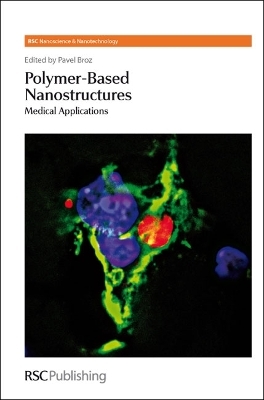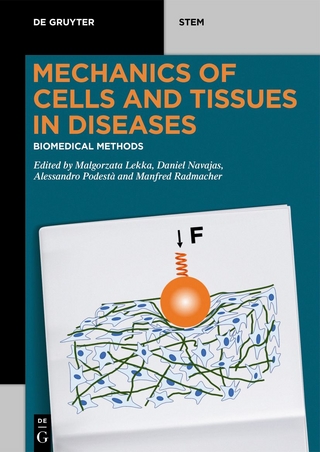
Polymer-based Nanostructures
Royal Society of Chemistry (Verlag)
978-0-85404-956-1 (ISBN)
Nanotechnology is about small things and medicine usually deals with bigger things - with patients and their diseases. The ultimate goal of all medical sciences is the healing of diseases whenever possible, otherwise the abatement of suffering. The first step of a successful medical treatment is the correct diagnosis of the disease or disease condition, based on clinical knowledge and experience and on diagnostic tools that give insight into macroscopic, microscopic, and biochemical properties of the disease process. Nanomaterials can improve currently available diagnostic applications in medicine and especially polymer-based nanostructures have an enormous potential to revolutionize the way how clinicians diagnose diseases correctly and efficiently. The second step when treating patients is a powerful and specific therapy that is low in side effects, that can prolong the survival of the patient or that can lower the burden of the disease. Again, polymer-based nanostructures are very promising novel tools that might change the way how certain diseases are being treated. This book combines both viewpoints and presents successful applications of nanotechnological constructs in medicine and the science behind the tools. Supramolecular nanometre-sized structures such as nanoparticles or vesicles built out of new synthetic polymeric materials have aroused enormous interest in recent years - both in chemical and pharmaceutical labs as well as in clinical medicine. They promise to be useful for novel or improved diagnostic and therapeutic applications for important diseases such as arteriosclerosis, cancer, infections, or autoimmune disorders. In the first part of this book, renowned researchers provide a detailed insight into both chemical and biological/pharmacological basics that have to be managed for successful applications of these nanostructures in human beings. In the second part, invited authors review the main literature in both diagnostic and therapeutic applications with polymer-based nanostructures that have already reached clinical practice or will enter it in the next few years. Key features include: -Multidisciplinary: The book is written by both clinicians from world-wide leading University Hospitals as well as researchers coming from natural sciences. Special effort was invested into comprehensibility across the traditional borders of medicine, pharmacology, and chemistry. -State-of-the-art: The book is filled with exciting contributions from some of the leading research groups in the field. This guarantees a clear emphasis on ongoing research and ground-breaking applications and projects -Structure: The book can be read from the beginning to the end, starting with basics that help to understand the current diagnostic and therapeutic applications of polymer-based nanostructures in medicine, ending with innovative multifunctional and "smart" nanostructures that might be the future of medicine. The way leads from solid foundations to nowadays applications and further to more futuristic approaches -References: The internationally renowned authors of the chapters have put great efforts into choosing only the most important and competitive papers for the reference lists. All major projects in this field are included - perfect for students or researchers that want to search the main literature thus avoiding the need to search through huge electronic databases
Dr Pavel Broz MD is at the University Hospital Basel, Switzerland.
1 - Foreword;
2 - Basics;
Polymer materials for biomedical application;
Factors influencing the polymer's applicability in biomedical fields;
References;
Contact;
Strategies for transmembrane passage of polymer-based nanostructures;
Introduction;
Peptides and proteins delivery;
Gene delivery;
General vaccines delivery;
Nanoparticles;
Strategies for Transmembrane Passage of Polymer-Based Nanostructures;
Gastrointestinal Transepithelial Permeability of Polymer-Based Nanostructures;
Mechanisms of Transepithelial Transport of Nanoparticles;
Paracellular Pathway;
Transcellular Pathway;
Strategies for Transepithelial Permeability of Polymer-Based Nanostructures through the Paracellular Pathway;
Strategies for Transepithelial Permeability of Polymer-Based Nanostructures through the Transcellular Pathway;
Modification of Polymer-Based Nanostructure Surfaces with Targeting Moieties (Targeted Delivery Systems);
Gastrointestinal Targeting of Nanoparticles with Surfaces Modified by Lectins;
M Cell Targeting with Polymer-Based Nanostructures Decorated With Lectins on the Surface;
Capability of M cells to absorb non-targeted nanoparticles;
Strategies for the absorption of targeted nanoparticles by M cells;
The use of lectins to target M cells for particulate uptake;
The use of Invasins to target M cells for particulate uptake;
M Cell Targeting with Polymer-Based Nanostructures Decorated With Antibody on the Surface;
Strategy Based on the Understanding and the Use of the right animal model and Conversion of Epithelia cells to M cells;
Enterocyte Targeting with Polymer-Based Nanostructures Decorated With Lectins on the Surface;
The Use of targeted lecitin-decorated particles to promote particulate absorption by the enterocytes;
The Use of targeted Vitamin B12-decorated particles to promote particulate absorption by the enterocytes;
The Use of targeted RGD peptide-decorated particles to promote particulate absorption by the enterocytes;
Colon Targeting with Polymer-Based Nanostructures Decorated With Lectins on the Surface;
Strategies for Gastrointestinal Delivery of Nanoparticles Using Bio-(Muco-) adhesion mechanism;
Bioadhesion and Mucoadhesion;
Bioadhesion of Polymer-Based Nanostructures;
Mucoadhesion Based on Non-specific Interactions;
Bioadhesion Based on Specific Interactions;
Bio-(muco) adhesive nanoparticles;
Chitosan;
Poly(lactide-co-glycolide) copolymer;
Poly(methylvinylether-co-maleic anhydride) (PVM/MA);
Poly(alkylcyanoacrylate);
Poly-fumaric anhydride-co-sebacic anhydride (P(FA:SA));
Methacrylic acid grafted with poly(ethylene glycol), and acrylic acid grafted with poly(ethylene glycol);
Hydroxypropyl- -cyclodextrin-insulin (HP CD-I) complex encapsulated polymethacrylic acid-chitosan-polyether (polyethylene glycol-polypropylene glycol copolymer) (PMCP) nanoparticles;
Ply(N-isopropylacrylamide) (PNIPAAm) hydrogel nanoparticles;
The Use Permeability Or Absorption Enhancers as a Strategy for Transepithelial Permeability of Nanoparticles;
Surfactants;
Chitosan and its derivatives;
Thiolated polymers;
Strategy based on the Influence of Particle Size on Transepithelial Permeability of Nanoparticles;
Nanoparticle Size and Vaccine Development;
Strategies Based on the Influence of Particle Surface Properties (Charge and hydrophobicity) on Transepithelial Permeability of Nanoparticles;
Strategies Based on Protein Transduction;
Historical Perspectives;
Cell-penetrating peptides (CPPs) involved in delivery of therapeutic agents;
Mechanism of Translocation;
Applications of CPP to Particulate Permeability;
Strategy for Permeability of Nanostructures Across Other Mucosal Epithelia;
Transepithelial permeability of polymer-based nanostructures across the lung epithelium;
Effect of Particle Size;
Mucoadhesion;
Targeting with Lectin;
Nasal route;
Ophthalmic route;
Size;
Mucoadhesion;
Surface Charge;
Strategies for Permeability of Polymer-Based;
Nanostructures Across Blood-Brain Barrier;
Surfactant;
Surface charge;
Particle size;
Antibody for targeting the Blood-Brain Barrier;
Lectin for targeting the Blood-Brain Barrier;
Nanogel for targeted delivery of drugs and macromolecules to the brain;
References;
Contact;
Nanoparticle Engineering for the Lymphatic System and Lymph Node Targeting;
Introduction;
Nanoparticle size;
Nanoparticle surface engineering;
Surface modification with serum;
Surface manipulation with block copolymers;
Recent trends in vesicular surface engineering;
Platform nanotechnologies;
Conclusions;
References;
Contact;
Strategies for Intracellular Delivery of Polymer-based Nanosystems;
Introduction;
Barriers to cellular transport of nanosystems;
Nanosystem-cell interactions and cellular internalization;
Intracellular trafficking of nanosystems;
Challenges;
References;
Contact;
Strategies for triggered release from polymer-based nanostructures;
Introduction;
Stimuli applied for triggered release;
Temperature;
Polymers based on LCST;
Polymers based on amphiphilic balance;
Polymeric nanovehicles for drug delivery with temperature-triggered release mechanism;
pH;
Anionic and cationic polymers;
Polymeric systems with acidic pH-cleavable bonds;
Polymeric nanovehicles for drug release by pH-triggered destabilization mechanism;
Other stimuli (light, electric fields, ionic strength, biomolecules, etc.);
Magnetic and electric field;
Ultrasound;
Light;
Specific interactions;
Channel proteins - candidates for triggers of drug release;
Antigen responsive polymers;
Enzyme-triggered drug delivery systems;
Glucose-responsive polymers;
Redox-sensitive systems;
References;
Contact;
Strategies for enhanced biocompatibility and biodegrability of polymer-based nanostructures;
3 - Polymer-based nanostructures for diagnostic applications;
Polymeric nanoparticles for medical imaging;
Introduction;
Polymeric particles in medical imaging;
MRI Contrast agents;
Overview;
Toward ideal contrast agents;
The case for nanoparticle agents: Gd-albumin experience;
The problem of MRI sensitivity;
References;
Type I, Linear chains, polylysine backbone;
Motivation;
Synthesis and Conformation;
Role of electric dipole centers on the polymer chain;
Transport rate blocking;
cRGD peptide effects;
Binding site density;
Scaling law;
Trans-endothelial transport: the new mechanism;
Cell-surface assisted migration;
Summary;
Tumor assessment;
References;
Type I, linear chains, dextran backbone;
Motivation and early results;
DOTA linked dextran;
Synthesis of carboxymethyldextran -A2-Gd-DOTA;
Clearance and safety;
Angiography;
Tumor assessment;
New DTPA-dextran constructs;
Dextran constructs for nuclear and optical imaging;
Summary;
References;
Type II, Dendrimers and globular particles;
Introduction;
Structures and synthesis of principle classes of dendrimers for imaging;
DTPA-dendrimers, principle characteristics;
DOTA linked dendrimer, Gadomer 17;
Structure and characteristics;
Biodistribution and elimination;
Dendrimer elimination and safety;
Remarks on safety;
Applications;
Angiography;
Lymph node evaluation;
Tumor characterization;
Summary;
Other constructs, targeting, and CT;
References;
Globular agents and endothelial pore size distribution;
Tumor endothelial leakiness, large pore dominance model;
Theoretical;
Pore size distribution in rat mammary tumors;
PEG linked Gd-DTPA-polylysine;
References;
Iron oxide nanoparticles;
Summary overview;
Developments;
Polymer coating;
Monomer coating;
Labeling of cells;
Cell trafficking;
Cell labeling II and detection limits;
Lymphocyte homing;
Single cell detection;
Signal nonlinearity;
Lymphography;
Gene expression;
Targeting;
Tumor assessment;
References;
Contact;
Polymeric vesicles/capsules for diagnostic applications in medicine;
Introduction;
Ex vivo Diagnostics;
Polymeric Nanoparticles;
Diagnostic Imaging;
X-Ray;
Liposomes;
Polymeric particles;
Gold particles;
Magnetic Resonance Imaging-contrast;
SPIOs and USPIOs;
Liposomes;
Dendrimers;
Ultrasound Contrast Agents;
Surfactant-stabilized nanobubbles;
Liquid Perfluorocarbons;
Solid nanoparticles;
Hollow Polymeric nanocapsules;
Imaging and Drug and Gene delivery;
Targeted UCA;
Gold nanoparticles and photoacoustic measurements;
Optical Imaging;
Radionuclide imaging;
Single photon emission computed tomography;
Positron emission tomography;
Conclusion;
References;
Contact;
4 - Polymer-based nanostructures for therapeutic applications;
Polymeric micelles for therapeutic applications in medicine;
Introduction;
Solubilization by micelles;
Polymeric micelles;
Micelle preparation, morphology, and drug loading;
Drug-loaded polymeric micelles in vivo;
targeted and stimuli-sensitive micelles;
Other applications of polymeric micelles;
Micelles in immunology;
Micelles as carriers of contrast agents;
Conclusion;
References;
Contact;
Polymeric particles for therapeutic applications in medicine;
Anti-Cancer Polymersomes;
Introduction;
Polymersome structure and properties;
Controlled release polymersomes;
Small molecule chemotherapeutics for shrinking tumors;
Efforts to target polymersomes;
Conclusions and opportune comparisons to copolymer micelles;
References;
Contact;
5 - Polymer-based nanostructures with an intelligent functionality;
Polymer-based nanoreactors for medical applications;
Introduction;
The nanoreactor toolbox;
Polymers;
Channels and enzymes used in nanoreactors;
Permeabilizing proteins;
Encapsulated proteins;
Preparation methods;
Ethanol method;
Film hydration method;
Direct dispersion method;
Functionalized reactors;
Targeting of nanoreactors to different tissues;
Controlling the activity of the nanoreactor;
Applications;
Open questions;
References;
Contact;
Nanoparticles for cancer diagnosis and therapy;
Introduction;
Cancer facts/problems;
Nanoparticle advantages for cancer therapy and imaging;
Nanoparticles for therapy;
Chemotherapy;
Polymeric nanoparticles;
Dendrimer;
Solid lipid nanoparticles (SLN);
Low density lipoprotein (LDL);
Radiotherapy;
Photodynamic Therapy (PDT);
Thermotherapy;
Nanoparticles for imaging;
Magnetic resonance imaging (MRI);
Optical Imaging;
X-ray Computed Tomography (CT);
Bimodal Imaging: MRI and Fluorescence Imaging;
Multitasking nanoparticles for integrated imaging and therapy;
Summary and future challenges;
Acknowledgements;
References;
Contact
| Reihe/Serie | Nanoscience & Nanotechnology Series ; Volume 9 |
|---|---|
| Co-Autor | Violeta Malinova, Wolfgang Meier |
| Mitarbeit |
Herausgeber (Serie): Harry Kroto, Paul O'Brien |
| Verlagsort | Cambridge |
| Sprache | englisch |
| Maße | 156 x 234 mm |
| Gewicht | 2065 g |
| Themenwelt | Medizin / Pharmazie |
| Technik ► Medizintechnik | |
| ISBN-10 | 0-85404-956-8 / 0854049568 |
| ISBN-13 | 978-0-85404-956-1 / 9780854049561 |
| Zustand | Neuware |
| Informationen gemäß Produktsicherheitsverordnung (GPSR) | |
| Haben Sie eine Frage zum Produkt? |
aus dem Bereich


